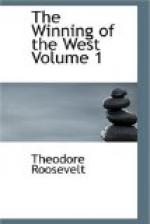6. August 22, 1734 (according to James Parton, in his sketch of Boon). His grandfather was an English immigrant; his father had married a Quakeress. When he lived on the banks of the Delaware, the country was still a wilderness. He was born in Berks Co.
7. The inscription is first mentioned by Ramsey, p. 67. See Appendix C, for a letter from the Hon. John Allison, at present (1888) Secretary of State for Tennessee, which goes to prove that the inscription has been on the tree as long as the district has been settled. Of course it cannot be proved that the inscription is by Boon; but there is much reason for supposing that such is the case, and little for doubting it.
8. He was by birth a Virginian, of mixed Scotch and Welsh descent. See Collins, II., 336; also Ramsey. For Boon’s early connection with Henderson, in 1764, see Haywood, 35.
9. Even among his foes; he is almost the only American praised by Lt.-Gov. Henry Hamilton of Detroit, for instance (see Royal Gazette, July 15, 1780).
10. John Finley.
11. “The Adventures of Colonel Daniel Boon, formerly a hunter”; nominally written by Boon himself, in 1784, but in reality by John Filson, the first Kentucky historian,—a man who did history good service, albeit a true sample of the small hedge-school pedant. The old pioneer’s own language would have been far better than that which Filson used; for the latter’s composition is a travesty of Johnsonese in its most aggravated form. For Filson see Durrett’s admirable “Life” in the Filson Club Publications.
12. The Nieblung Lied tells of Siegfried’s feats with bear, buffalo, elk, wolf, and deer:
“Danach schlug er wieder einen Buffel und einen Elk Vier starkes Auer nieder und einen grimmen Schelk, So schnell trug ihn die Mahre, dasz ihm nichts entsprang; Hinden und Hirsche wurden viele sein Fang. ....... ein Waldthier furchterlich, Einen wilden Baren.”
Siegfried’s elk was our moose; and like the American frontiersmen of to-day, the old German singer calls the Wisent or Bison a buffalo—European sportsmen now committing an equally bad blunder by giving it the name of the extinct aurochs. Be it observed also that the hard fighting, hard drinking, boastful hero of Nieblung fame used a “spur hund,” just as his representative of Kentucky or Tennessee used a track hound a thousand years later.
13. His name was John Stewart.
14. His remaining absolutely alone in the wilderness for such a length of time is often spoken of with wonder; but here again Boon stands merely as the backwoods type, not as an exception. To this day many hunters in the Rockies do the same. In 1880, two men whom I knew wintered to the west of the Bighorns, 150 miles from any human beings. They had salt and flour, however; but they were nine months without seeing a white face. They killed elk, buffalo, and a moose; and had a narrow escape from a small Indian war party. Last winter (1887-88) an old trapper, a friend of mine in the days when he hunted buffalo, spent five months entirely alone in the mountains north of the Flathead country.




